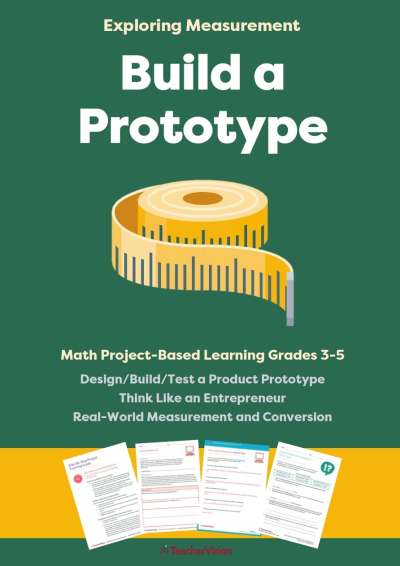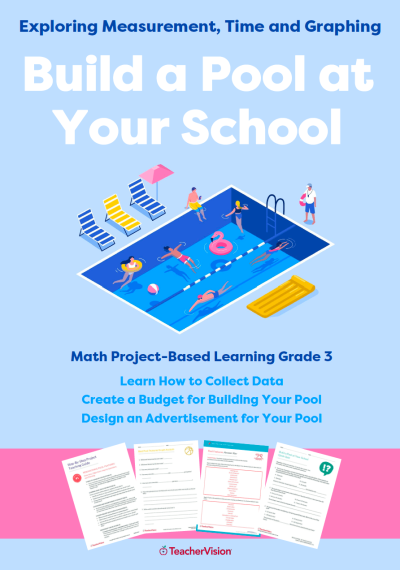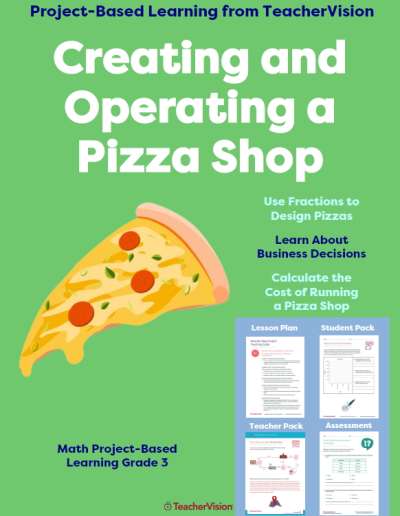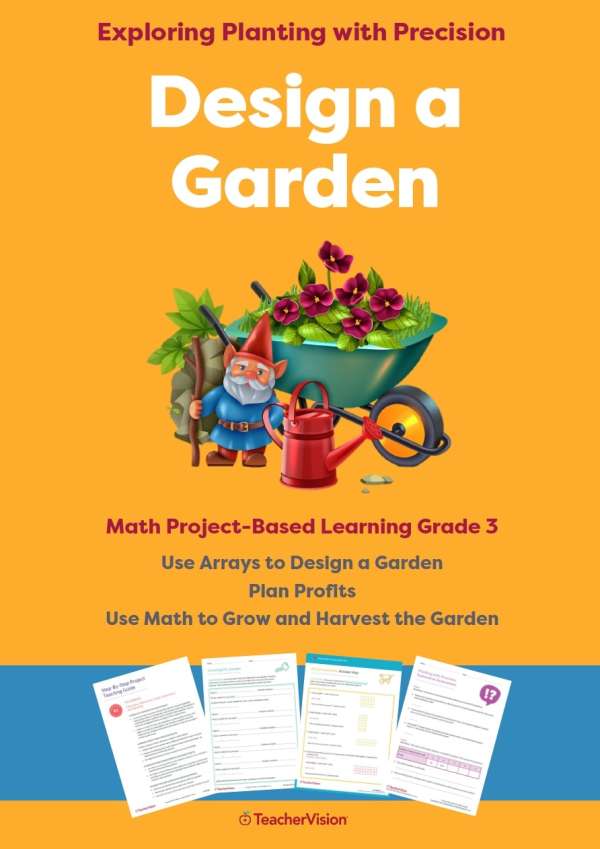
Included with a Premium Membership
Subscribe for instant access to this and every resource on TeacherVision.
CCSS-Aligned Lesson on Using Multiplication, Division, and Other Operations in Real-World Applications!
Students will apply their multiplication and division skills in planning, plotting, planting and harvesting a garden, and then work with all four operations to determine pricing and profit for selling their produce at market.
This PBL unit for 3rd grade math will give your students am interesting, engaging, and collaborative way to practice the addition, subtraction, multiplication, and division skills they've learned while applying them to a real-world application. Using critical-thinking and problem-solving skills backed with data derived from real-world math, they will work individually and together to plan, plot, plant, harvest and sell the produce from a garden.
What’s Inside
Packed with fun, hands-on activities, extension and enhancement ideas, opportunities for independent and group work, and engaging inquiry-based challenges, this 54-page project-based unit comes complete with:
- For the Teacher: Engaging math lessons with teacher notes, step-by-step instructions for all activities, assessment guidance, and inquiry questions.
- For Students: A full-color Student Pack complete with all of the printables, slides, photos, and instructions students need for the activities - just print (or share) and teach!
A complete, ready-to-teach Teacher Pack that includes:
- Teacher versions of all the student printables with step-by-step annotations and notes for teaching application of operations;
- Formative and summative assessments, answer keys, and a full project rubric;
- Instructions and guidance for the extension activities and project enhancements;
- Materials and resources lists, links to articles, videos, and research, plus additional resources for lecture and presentation.
What's Included
- Lesson Plan - Step-by-Step Project Teaching Guide
- Milestone 1: Planning
- Milestone 2: Plotting
- Milestone 3: How Does Your Garden Grow?
- Milestone 4: Harvest Time
- Milestone 5: Let's Go to Market!
Teacher and Student Resources
- Materials Needed for the Projects in this Unit
- Books About Gardens
- Multiplication Using Arrays Activity and Answer Key
- Arrays and Area Activity and Answer Key
- Exploring Multiplication Quick Quiz and Answer Key
- Growing Vegetables from Scraps Handout
- Planting with Precision Summative Assessment and Answer Key
- Planting with Precision Project Rubric
- Planning My Plants Activity Part 1
- Planning My Plants Activity Part 2
- Garden Planning Grid Handout
- Milestone #1 Inquiry Question
- Arrays and Area Activity
- Size Up the Space Area Activity
- Milestone #2 Inquiry Question
- Growing My Garden Estimation Activity
- Milestone #3 Inquiry Question
- Harvest Time Calculation Activity
- Milestone #4 Inquiry Question
- Produce Profits Planning Sheet
- Let's Go To Market! Activity
- Profit Patterns Activity
- Milestone #5 Inquiry Question
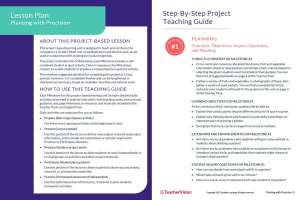
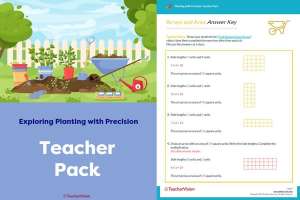
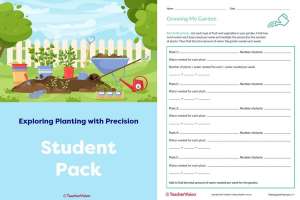
OVERVIEW:
This project-based learning lesson is designed to support and reinforce the concepts in a Grade 3 math unit on using multiplication and division, along with addition and subtraction, to solve real-world math problems. It is built around 5 inquiry-based milestones that incorporate cross-curricular hands-on projects, formative and summative assessments, independent and group activities, and extensions.
STUDENT/GROUP OUTPUT:
In the course of this project-based learning unit, students will:
Multiply and divide with groups and arrays;
Plan and plot a garden using multiplication, measurement, and estimation;
Use multiplication, division, and other operations to determine how to tend and harvest the garden;
Use addition, subtraction, multiplication, and division to determine quantities and profit of produce sold at market.
SUGGESTED SUBJECT PREREQUISITES:
Students should have background knowledge of multiplying, dividing, adding, subtracting, and measurement as part of this project, and instructional materials for providing refreshers and instruction are included in the Teacher Pack.
SEQUENCE AND PACING:
This project-based unit is divided into 5 milestones. The minimum suggested duration for completing this project-based unit is 5 class periods. However, the unit is completely flexible and can be lengthened or shortened as necessary or desired, based on available class time and interest level.
TECHNOLOGY RESOURCES (suggested):
Internet access
STANDARDS ALIGNMENT
MILESTONE #1
• CCSS.MATH.CONTENT.3.OA.A.1 - Interpret products of whole numbers, e.g., interpret 5 × 7 as the total number of objects in 5 groups of 7 objects each.
• CCSS.MATH.CONTENT.3.OA.A.3 - Use multiplication and division within 100 to solve word problems in situations involving equal groups, arrays, and measurement quantities, e.g., by using drawings and equations with a symbol for the unknown number to represent the problem.
MILESTONE #2
• CCSS.MATH.CONTENT.3.OA.A.1 - Interpret products of whole numbers, e.g., interpret 5 × 7 as the total number of objects in 5 groups of 7 objects each.
• CCSS.MATH.CONTENT.3.OA.A.2 - Interpret whole-number quotients of whole numbers, e.g., interpret 56 ÷ 8 as the number of objects in each share when 56 objects are partitioned equally into 8 shares, or as a number of shares when 56 objects are partitioned into equal shares of 8 objects each.
• CCSS.MATH.CONTENT.3.OA.A.3 - Use multiplication and division within 100 to solve word problems in situations involving equal groups, arrays, and measurements quantities.
• CCSS.MATH.CONTENT.3.OA.B.5 - Apply properties of operations as strategies to multiply and divide.
• CCSS.MATH.CONTENT.3.OA.C.7 - Fluently multiply and divide within 100, using strategies such as the relationship between multiplication and division.
• CCSS.MATH.CONTENT.3.OA.D.8 - Solve two-step word problems using the four operations. Represent these problems using equations with a letter standing for the unknown quantity. Assess the reasonableness of answers using mental computation and estimation strategies including rounding.
MILESTONE #3
• CCSS.MATH.CONTENT.3.OA.A.1 - Interpret products of whole numbers, e.g., interpret 5 × 7 as the total number of objects in 5 groups of 7 objects each.
• CCSS.MATH.CONTENT.3.OA.A.2 - Interpret whole-number quotients of whole numbers, e.g., interpret 56 ÷ 8 as the number of objects in each share when 56 objects are partitioned equally into 8 shares, or as a number of shares when 56 objects are partitioned into equal shares of 8 objects each.
• CCSS.MATH.CONTENT.3.OA.A.3 - Use multiplication and division within 100 to solve word problems in situations involving equal groups, arrays, and measurements quantities.
• CCSS.MATH.CONTENT.3.OA.C.7 - Fluently multiply and divide within 100, using strategies such as the relationship between multiplication and division.
• CCSS.MATH.CONTENT.3.OA.D.8 - Solve two-step word problems using the four operations. Represent these problems using equations with a letter standing for the unknown quantity. Assess the reasonableness of answers using mental computation and estimation strategies including rounding.
MILESTONE #4
• CCSS.MATH.CONTENT.3.OA.A.3 - Use multiplication and division within 100 to solve word problems in situations involving equal groups, arrays, and measurement quantities.
• CCSS.MATH.CONTENT.3.OA.C.7 - Fluently multiply and divide within 100, using strategies such as the relationship between multiplication and division.
• CCSS.MATH.CONTENT.3.OA.D.8 - Solve two-step word problems using the four operations. Represent these problems using equations with a letter standing for the unknown quantity. Assess the reasonableness of answers using mental computation and estimation strategies including rounding.
MILESTONE #5
• CCSS.MATH.CONTENT.3.OA.A.3 - Use multiplication and division within 100 to solve word problems in situations involving equal groups, arrays, and measurement quantities.
• CCSS.MATH.CONTENT.3.OA.C.7 - Fluently multiply and divide within 100, using strategies such as the relationship between multiplication and division.
• CCSS.MATH.CONTENT.3.OA.D.8 - Solve two-step word problems using the four operations. Represent these problems using equations with a letter standing for the unknown quantity. Assess the reasonableness of answers using mental computation and estimation strategies including rounding.
• CCSS.MATH.CONTENT.3.OA.D.9 - Identify arithmetic patterns (including patterns in the addition table or multiplication table), and explain them using properties of operations.


